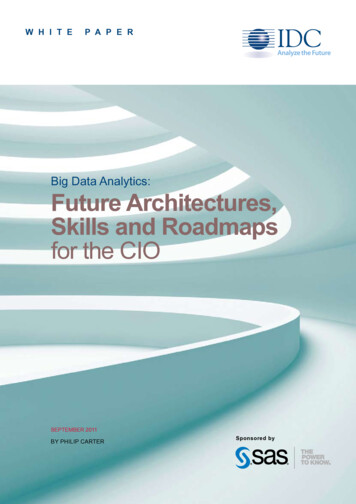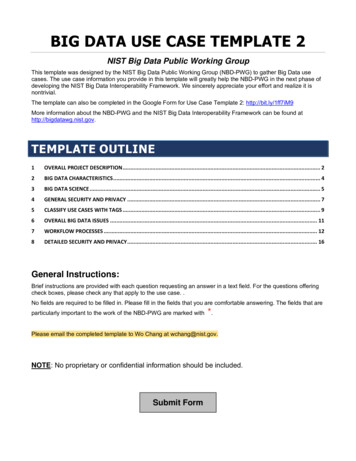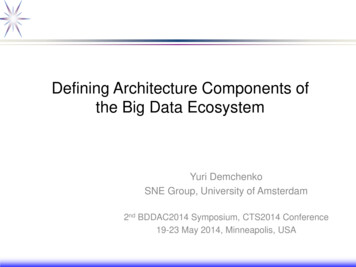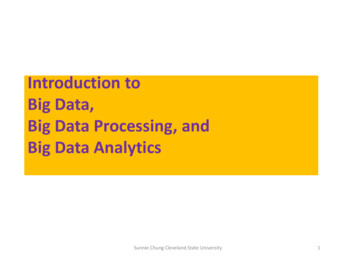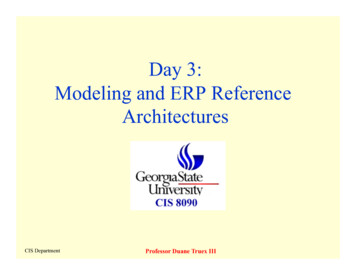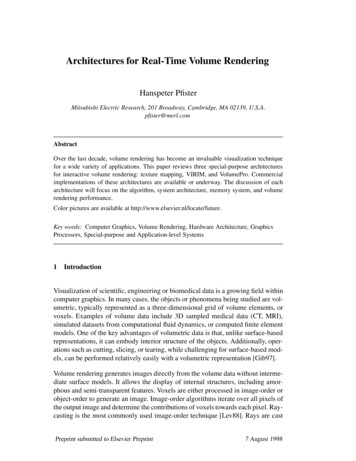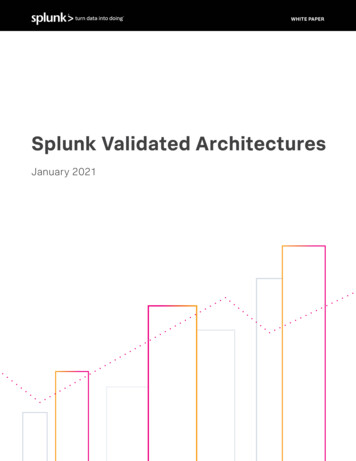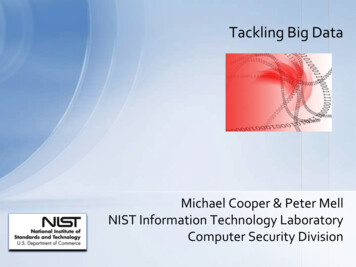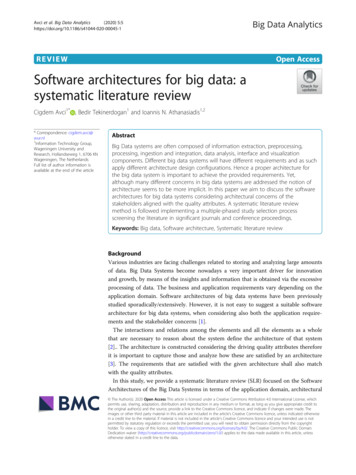
Transcription
Avci et al. Big Data Analytics(2020) WBig Data AnalyticsOpen AccessSoftware architectures for big data: asystematic literature reviewCigdem Avci1* , Bedir Tekinerdogan1 and Ioannis N. Athanasiadis1,2* Correspondence: cigdem.avci@wur.nl1Information Technology Group,Wageningen University andResearch, Hollandseweg 1, 6706 KNWageningen, The NetherlandsFull list of author information isavailable at the end of the articleAbstractBig Data systems are often composed of information extraction, preprocessing,processing, ingestion and integration, data analysis, interface and visualizationcomponents. Different big data systems will have different requirements and as suchapply different architecture design configurations. Hence a proper architecture forthe big data system is important to achieve the provided requirements. Yet,although many different concerns in big data systems are addressed the notion ofarchitecture seems to be more implicit. In this paper we aim to discuss the softwarearchitectures for big data systems considering architectural concerns of thestakeholders aligned with the quality attributes. A systematic literature reviewmethod is followed implementing a multiple-phased study selection processscreening the literature in significant journals and conference proceedings.Keywords: Big data, Software architecture, Systematic literature reviewBackgroundVarious industries are facing challenges related to storing and analyzing large amountsof data. Big Data Systems become nowadays a very important driver for innovationand growth, by means of the insights and information that is obtained via the excessiveprocessing of data. The business and application requirements vary depending on theapplication domain. Software architectures of big data systems have been previouslystudied sporadically/extensively. However, it is not easy to suggest a suitable softwarearchitecture for big data systems, when considering also both the application requirements and the stakeholder concerns [1].The interactions and relations among the elements and all the elements as a wholethat are necessary to reason about the system define the architecture of that system[2]. The architecture is constructed considering the driving quality attributes thereforeit is important to capture those and analyze how these are satisfied by an architecture[3]. The requirements that are satisfied with the given architecture shall also matchwith the quality attributes.In this study, we provide a systematic literature review (SLR) focused on the SoftwareArchitectures of the Big Data Systems in terms of the application domain, architectural The Author(s). 2020 Open Access This article is licensed under a Creative Commons Attribution 4.0 International License, whichpermits use, sharing, adaptation, distribution and reproduction in any medium or format, as long as you give appropriate credit tothe original author(s) and the source, provide a link to the Creative Commons licence, and indicate if changes were made. Theimages or other third party material in this article are included in the article's Creative Commons licence, unless indicated otherwisein a credit line to the material. If material is not included in the article's Creative Commons licence and your intended use is notpermitted by statutory regulation or exceeds the permitted use, you will need to obtain permission directly from the copyrightholder. To view a copy of this licence, visit http://creativecommons.org/licenses/by/4.0/. The Creative Commons Public DomainDedication waiver ) applies to the data made available in this article, unlessotherwise stated in a credit line to the data.
Avci et al. Big Data Analytics(2020) 5:5viewpoints, architectural patterns, architectural concerns, quality attributes, designmethods, technologies and stakeholders. The challenging part of the study was screening the publications from various domains. The variety of the application areas of bigdata systems brings along the dissimilar representations of the system architectureswith flexible terminologies. In order to achieve the requirements provided by differentstakeholders which derive different architectural configurations, a proper architecturaldesign with consistent terminology is essential. We aim to focus on the software architectures for big data systems considering architecture design configurations derived byarchitectural concerns of the stakeholders aligned with the quality attributes which areimplicit in design of various systems.The application areas of the big data systems vary from aerospace to healthcare [4,5], and depending on the application domain, the functional and non-functionalconcerns vary accordingly, influencing both the architectural choices and the implementation of big data systems. To shed light on the experiences reported in the recentliterature with deploying big data systems in various domain applications, we conducted a systematic literature review. Our aim was to consolidate reported experienceby documenting architectural choices and concerns, summarizing the lessons learnedand provide insights to stakeholders and practitioners with respect to architecturalchoices for future deployment of big data systems.The study aims to investigate the big data software architectures based on application domains assessing the evidence considering the interrelation among the dataextraction area and the quality attributes with the systematic literature reviewmethodology which is the suitable research method. Our research questions are derived to find out in which domains big data is applied, the motivation for adoptingbig data architectures and to identify the existing software architectures for bigdata systems We identified 622 papers with our search strategy. Forty-three ofthem are identified as relevant primary papers for our research. In order to identifyvarious aspects related to the application domains, we extracted data for selectedkey dimensions of Big Data Software Architectures, such as current architecturalmethods to deal with the identified architectural constraints and quality attributes.We presented the findings of our systematic literature review to help researchersand practitioners aiming to understand the application domains involved in designing big data system software architectures and the patterns and tactics available todesign and classify them.Big dataThe term “Big Data” usually refers to data sets with sizes beyond the ability ofcommonly used software tools to capture, curate, manage, and process data within atolerable elapsed time. In general, Big Data can be explained according to three V’s:Volume (amount of data), Velocity (speed of data), and Variety (range of data typesand sources). The realization of Big Data systems relies on disruptive technologies suchas Cloud Computing, Internet of Things and Data Analytics. With more and moresystems utilizing Big Data for various industries such as health, administration, agriculture, defense, and education, advances by means of innovation and growth have beenmade in the application areas. These systems represent major, long-term investmentsPage 2 of 53
Avci et al. Big Data Analytics(2020) 5:5requiring considerable financial commitments and massive scale software and systemdeployments.The big data systems are applicable to the data sets that are not tolerable by theability of the generic software tools and systems [6]. The contemporary technologieswithin the area of cloud computing, internet of things and data analytics are requiredfor the implementation of the big data systems. Such massive scale systems are implemented using long term investments within the industries such as health, administration, agriculture, defense and education [7].Big data systems analytic capability strongly depends on the extreme coupling of thearchitecture of the distributed software, the data management and the deployment.Scaling requirements are the main drivers to select the right distributed software, datamanagement and deployment architecture of the big data systems [8]. Big datasolutions led to a complete revolution in terms of the used architecture, such as scaleout and shared-nothing solutions that use non-normalized databases and redundantstorage [9].As a sample domain, space business already benefits from the big data technologyand can continue improving in terms of, for instance horizontal scalability (increasingthe capacity by integrating software/hardware) to meet the mission needs instead ofprocuring high end storage server in advance. Besides multi-mission data storageservices can be enabled instead of isolated mission-dedicated warehouse silos. Improvedperformance on data processing and analytics jobs can support activities such as earlyanomaly detection, anomaly investigation and parameter focusing. As a result, big datatechnology is transforming data-driven science and innovation with platforms enablingreal time access to the data for integrated value.The trend is to increase the role of information and value extracted from the data bymeans of improving the technologies for automatic data analysis, visualization and usefacilitating machine learning and deep learning or utilizing the spatio-temporalanalytics through novel paradigms such as datacubes.Systematic reviewsThe systematic literature review is a rigorous activity that is applied screening theidentified studies and evaluating such studies based on the defined research questions,topic areas or phenomenon of interest. As a result of the evidence gathered for aparticular topic, the gaps can be investigated further with supporting studies.Evidence-based research is successfully conducted initially in the field of medicineand similar approaches are adopted in many other disciplines. Among the goals of theevidence-based software engineering, the quality improvement, assessing the application extent of the best practices for the software-intensive systems can be listed. Besidesthe evidence based guidelines can be provided to the practitioners as a result of suchstudies. Considering the benefits of the evidence based research, its application isvaluable also in the software engineering field.The systematic literature review shall be transparent and objective. Defining clearinclusion/exclusion criteria for the selected primary studies is critical for the accuracyand consistency of the output of the review. Well defined inclusion/exclusion criteriaminimizes the bias and simplifies the integration of the new findings.Page 3 of 53
Avci et al. Big Data Analytics(2020) 5:5Software architecturesThe software architecture is the high-level representation and definition of asoftware system providing the relationships between architectural elements andsub-elements with a required level of granularity [3, 10]. Views and beyond is oneof the approaches to define and document the software architectures [11]. Viewpoints are generated to focus on relevant quality attributes based in the area of usefor the stakeholder and more than one viewpoint can be adopted depending onthe complexity of the defined system. In order to solve common problems withinthe architecture, architectural patterns are designed within the relevant context.Architectural patterns, templates and constraints are consolidated and described inviewpoints.Research methodIn this study, the SLR is applied for the software architectures of big data systemsfollowing the guidelines proposed in [12, 13] by Kitchenham and Charters. The reviewprotocol that is followed is defined in the following sections.Review ProtokolIn order to apply the systematic literature review, a review protocol shall be definedwith the methods to be used for reducing the overall bias. Figure 1 below shows thereview protocol that is followed throughout this study:The research questions are defined using the objectives of the systematic review asdiscussed in section 3.2 which is followed by drawing the scope (time range andpublication resources) and the strategy (section 3.3). The search strategy is shaped byconducting pilot searches to form the actual search strings.Fig. 1 Review ProtocolPage 4 of 53
Avci et al. Big Data Analytics(2020) 5:5Fig. 2 Year-wise distribution of primary stuides. * One study that is reviewed in 2016, published in 2017 isincluded among the publication list.The appropriate definition of the search string reduces the bias and helps toachieve the target precision. The inclusion/exclusion criteria (section 3.4) is definedas the next step. The primary studies are filtered applying the inclusion/exclusioncriteria. The success of the study selection process is assessed via the peer reviewsof the authors.The selected primary studies are passed through a quality assessment (section3.5). Afterwards the data extraction strategy is built to gather the relevant information from the selected set of studies (section 3.6). The data extraction form isconstructed and filled with the corresponding output to present the results of thedata synthesis.Research questionsConstructing the research questions in the right way increases the relevancy of thefindings and the accuracy of the SLR output. Validity and significance of the researchquestions is critical for the target audience of the SLR. Considering the fact that we areinvestigating the software architectures of the big data systems, the following researchquestions are defined to examine the evidence:RQ.1:RQ.2:RQ.3:RQ.4:In which domains is big data applied?Why are the big data architectures applied?What are the existing software architecture approaches for big data systems?What is the strength of evidence of the study?Search strategyIn this section, our search strategy is defined to find as many primary studies aspossible regarding the research questions listed in section 3.2.Page 5 of 53
Avci et al. Big Data Analytics(2020) 5:5Scope The search scope of our study consists of the publication period as January 2010and December 2017 and search databases such as: IEEE Xplore, ACM Digital Library,Wiley Inter Science Journal Finder, ScienceDirect, Springer Link. Our targeted searchitems were both journal and conference papers.Method Automatic and manual search are applied to search the databases.In order to gather the right amount of relevant studies out of a high number ofsearch process outputs, the selection criteria shall be aligned with the objectives ofthe SLR. A search strategy with high recall causes false positives and a precisesearch strategy will narrow down the outcome.Initially a manual survey is conducted to analyze and bring out the search strings.Using this outcome, search queries are formed and run to obtain the right set of studieswith optimum precision and recall rates.The right method shall be applied to design the search strings with the relevant set ofkeywords which is critical for optimum retrieval of the studies. The keywords withinthe references section shall be eliminated and the keywords of the authors shall havehigher weight. By means of the concrete set of keywords, the final search string isformed.After the construction of the search strings, they are semantically adapted to theelectronic data sources and extended via OR and AND operators. A sample searchstring is presented below:Query 1:(((“Abstract”: “Big Data” OR “Publication Title”: “Big Data”) AND (p Abstract:“Software Architecture” OR “Abstract”: “System Architecture” OR “Abstract”: “CloudArchitecture” OR “Publication Title”: “Architecture”)))Other search strings can be found in Appendix 1. Eliminating the duplicate publications, 662 papers are detected.Study selection criteriaIn order to omit the studies that are irrelevant, out of scope or false positive, alignedwith the SLR guidelines, we apply the following exclusion criteria: EC 1: Papers that does not state a big data architecture description, or a big dataapplication that applies an architecture. EC 2: Papers that are not related to a field of computer science. EC 3: Papers are written in different language than English EC 4: Workshop papers EC5: Papers that does not discuss (or discuss partially) the big dataarchitecture EC6: Papers don’t explicitly present the architectural representation/view/modelAfter the exclusion criteria is applied, the reduced amount of studies arepresented in Table 1 where after applying EC1-EC5, which narrowed down ourcorpus to 341 papers. After applying criterion EC6, we concluded with 43 papers.Page 6 of 53
Avci et al. Big Data Analytics(2020) 5:5Page 7 of 53Table 1 Search results after the application of the elimination criteriaSourceAfter Applying Search QueryAfter EC1-EC5 AppliedAfter EC6 AppliedIEEE Xplore1133420ACM Digital Library111179Wiley Interscience10022Science Direct4859Springer250203Total62234143Study quality assessmentThe quality of the selected studies shall also be assessed based on a checklist. The aimof the quality assessment is the improvement of the relevance and importance of theresults via fine tuning the inclusion/exclusion criteria, driving the interpretation of theresults (data extraction and synthesis) and recommendations. The checklist should beconstructed considering the factors for each study. The factors that have a biasing effect on the outcome are used to form the quality checklist presented in Table 2. Thestudies are ranked according to the three point scale with the corresponding assignedscores (yes 1, somewhat 0.5, no 0). The assessment results can be found in Appendix 2 (List of Primary Studies).Data extractionThe data is extracted from the 43 studies selected targeting the review questionsand study quality criteria. The standard columns such as title, date, author are included in the data extraction form, in addition to the data extraction columnsaligned with the research questions which are application domain, architecturalviewpoints, patterns, concerns, quality attributes, etc. The field categories and fieldsare listed in Table 3.Data synthesisAfter gathering the data aligned with the data extraction form, the data is synthesized to obtain the answers for the predefined research questions. The qualitativeTable 2 Quality ChecklistNoQuestionQ1Are the aims of the study is clearly stated?Q2Are the scope and context of the study clearly defined?Q3Is the proposed solution clearly explained and validated by an empirical study?Q4Are the variables used in the study likely to be valid and reliable?Q5Is the research process documented adequately?Q6Are the all study questions answered?Q7Are the negative findings presented?Q8Are the main findings stated clearly in terms of creditability, validity and reliability?Q9Do the conclusions relate to the aim of the purpose of study?Q10 Does the report have implications in practice and results in research area for big data softwarearchitecture?
Avci et al. Big Data Analytics(2020) 5:5Page 8 of 53Table 3 Data Extraction ColumnsCategoryData Extraction ColumnsApplication Domain CategoriesCyber securityIOT/Smart citiesSocial big dataIncident/Anomaly detectionHealthcareAerospaceStakeholdersEnterprise managersStrategic chnical staffBusiness analystsData scientistsOperation managersData platform designersKey ConcernsIntegration concernsFunctional concernsNon-functional concernsMotivation for adopting a big data architectureDescription/MoltivationArchitectural ApproachesHybrid and othersArchitectural Models/ViewpointsDecomposition, deployment and othersArchitectural Tactics/PatternsFlow chart, layered, cloud based and othersassessment is covered interpreting the content of the data and assessing itsrelevance and relation with other categories/columns while the quantitative assessment is accomplished calculating the quality score for reporting, relevance, rigorand credibility.We investigated whether the qualitative results can lead us to explain quantitative results. We realized that application architectures are seldom based on a reference architecture in the papers that we reviewed. The analyzed papers mainlyelaborate and evaluate the target area using test cases, experiments and othermethods that are quantitative in nature however the data used is not available foreach case. They also target the research audiences beyond computer science, andthe reported data from the computer science point of view is rather limited. Thecoverage of a possible statistical analysis is not sufficient, however qualitative analysis is applicable for our case.The data synthesized is transferred to tabular and graphical representations topresent the reader an enriched and meaningful translation of the findings whichenables and simplifies the process of comparisons across categories, applicationareas and studies. Both qualitative and quantitative findings are valid inputs forfuture application areas within big data software architectures.
Avci et al. Big Data Analytics(2020) 5:5Grading of recommendation assessment, development and evaluation (GRADE)GRADE (Grading of Recommendations, Assessment, Development and Evaluations) [2]framework is a systematic approach with a transparent framework to gather andpresent evidence and measure the quality of it. The method assesses the likelihood ofbias at the outcome and is widely adopted by ensuring a transparent link between theevidence and recommendations. The results of application of the GRADE methodologyis presented in Section 4.4 for research question RQ4.ResultsOverview of the reviewed studiesThe selected 43 primary studies are briefly summarized below: Study 1: This article proposes a five-level of fusion model, in order to process the big datasets with complex magnitudes. Hadoop Processing Server is used. A fourlayered network architecture is presented.Study 2: presents AsterixDB, a Big Data Management System. Its target applicationareas can be listed as web data warehousing, social data storage and analysis, etc. Itimplements a flexible NoSQL style data model and transaction support similar tothat of a NoSQL store.Study 3: A Big Data architecture for construction waste analytics is proposed. Agraph database (Neo4J) and Spark is employed. Building Information Modelling(BIM) is investigated for possible extensions.Study 4: In order to design and deploy the scientific applications into the cloud inan agile way, the Scientific Platform for the Cloud (SPC) is developed. The platformembodies a web interface, job scheduling, real-time monitoring etc. PopulationGenetics, Geophysics, Turbulence Physics, DNA analysis, and Big Data can be listedamong the application domains.Study 5: The software architecture presented in this paper is developed to supportgathering of IoT sensor-based data in a cloud-based system. The use case is theSMARTCAMPUS project.Study 6: A scalable workflow-based cloud platform is implemented based onHadoop, Spark, Cassandra, Docker, and R. High performance and productivity isaimed. Data storage and management, data mining and machine learningcapabilities are involved.Study 7: WaaS is a standard and service platform architecture for big data. Fourservice layers implements four components accordingly.Study 8: The study describes the architecture-centric agile big data analytics whichis a methodology that combines big data software architecture analysis and designtogether with agile practices.Study 9: The system architecture of the City Data and Analytics Platform isintroduced in this paper. A smart city testbed, SmartSantander, is implementedbased on this architecture.Study 10: This paper discusses how to design big data system architectures usingarchitectural tactics considering the design tradeoffs. A healthcare informatics usecase is illustrated.Page 9 of 53
Avci et al. Big Data Analytics(2020) 5:5 Study 11: Private cloud computing platform which is developed for the China Centre for Resources Satellite Data and Application (CCRSDA) and its architecturaldesign is discussed in this paper.Study 12: Semantic-based heterogeneous multimedia retrieval architecture isdescribed in this paper. A NoSQL-based approach to process multimedia data indistributed in parallel and a map-reduce based retrieval algorithm are employed.Study 13: A cloud computing-based system architecture is presented forimplementation of a production tracking and scheduling system. A prototypesystem is implemented and validated in terms of its efficiency.Study 14: A distributed system architecture for text-based social data (Twitter,YouTube, The New York Times etc) is introduced in this paper. HDFS, Mapreduce, and message service analysis are utilized to analyze reputation, social trends,and customer reactions.Study 15: The Alexandria provides a framework and platform for big-data analyticsand visualisations mainly for text-based social media data. REST-based service APIsare heavily used within the system architecture.Study 16: Software architectures for Web Observatories are discussed in this paper,for processing real time web streams.Study 17: A generic system architecture is proposed in this paper, which focuseson running big data workflows in the cloud. Big data workflows are investigated inAmazon EC2, FutureGrid Eucalyptus and OpenStack clouds.Study 18: Big Data and data warehousing architectures and design are discussed inthis book for the next-generation data warehouse.Study 19: A general system architecture for big data analytics is proposed in thispaper, focusing on manufacturing industries.Study 20: This paper discusses the big data with the concept of e-learning and academic environment. A three-step system architecture presented based on a Cloudenvironment. Graphical Gephi tool is used for analyzing unstructured data.Study 21: An agent oriented architecture is presented in this paper and theproposed for the IoT domain.Study 22: CityWatch framework, which is designed for data sensing anddissemination by using the data collected from Dublin. Two prototype applicationsare implemented.Study 23: This paper discusses real time big data application architecturechallenges. Initial implementation is Hadoop-based which is later replaced with acustom in-memory processing engine.Study 24: This paper focuses on the analysis of the data produced by camerasensors for intruder detection and construction of barrier. A three-layered big dataanalytics architecture is designed for the study.Study 25: A Big Data architecture system design is introduced in this paper forglobal financial institutions. Hadoop and no-SQL are applied within the architecture, besides the architecture complies with the data integration, transmission andprocess orchestration requirements of the application domain.Study 26: A cloud architecture for healthcare is proposed in this paper. Inorder to use heterogenous devices as data sources, cloud middleware is utilized.Besides different healthcare platforms are integrated via the cloud middleware.Page 10 of 53
Avci et al. Big Data Analytics (2020) 5:5The paper also mentions the security and management concerns andemphasizes the importance of the standardized interfaces for the integrationwith medical devices.Study 27: The paper discusses the social CRM by means of architecturalperspectives using five layers.Study 28: In this paper, a technology independent reference architecture isproposed for big data systems. Real use cases are investigated and implementationtechnologies and products are classified.Study 29: Within the domain of educational technology, based on the Experience APIspecification, a big data software architecture is introduced in this paper. The datagenerated as a result of the learning activities of a course is used for the data analytics.Study 30: A big data analytical architecture for a remote sensing satelliteapplication is described in this paper. The data gathered from an earth observatorysystem is analysed in real time and stored using Hadoop.Study 31: A novel mobile-based end-to-end architecture is described in this study,for the healthcare domain. The architecture is specialized for live monitoring andvisualization of life-long diseases. The architecture is based on web services andSOA and a supporting Cloud infrastructure.Study 32: This paper proposes a two-layered cloud architecture for real-time publicopinion monitoring model.Study 33: Based on a search cluster for data indexing and query, a cloud servicearchitecture is introduced in this paper. The architecture has the capability tointegrate with Hadoop and Spark. REST APIs are employed for access.Study 34: An analytical big data framework is presented in this paper for the smartgrid domain. EU funded project BIG and the German funded project PEC are thecase studies.Study 35: A big data application architecture for smart cities is implementedwithin this study. Identify and responding to anomalous and hazardous events inreal time is the main goal of the designed architecture. Sensor data is used andsequential learning algorithms are adopted.Study 36: The architecture presented within this paper is for both offline and realtime processing and applied for the recommender systems.Study 37: A cloud based big data software application architecture is presented inthis paper. The target application domain is research/science. Open source softwareparadigm is emphasised.Study 38: A real time data-analytics-as-service architecture with RESTful web services is presented in this paper. The architectural challenges are discussed by meansof big data processing frameworks, reliability, real time performance and accuracy.Study 39: In this paper, Banian system’s 3-layer system architecture is discussed.The layers are listed as follows: storage, scheduling, application. The results arecompared with Hive.Study 40: A novel architecture of big data for assessing the city traffic state i
architecture for big data systems, when considering also both the application require-ments and the stakeholder concerns [1]. The interactions and relations among the elements and all the ele



